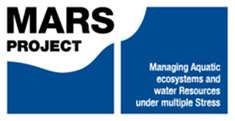Table of contents
What is a state?
The condition of the system under study (e.g. water body) resulting from both natural and anthropogenic factors (i.e. physical, chemical and biological characteristics).

WISER method database: Searching tool for assessment methods
WISER Methods database
This database contains information about the national assessment methods used to classify the ecological status of European rivers, lakes, coastal and transitional waters (Birk et al. 2012). Member States of the European Union apply these methods in their monitoring programmes according to the EU Water Framework Directive. Enter the WISER method database to search for the different methods to assess the biological quality elements in European countries (Birk et al. 2010).
Benchmark Indicators
For a streamlined analysis of multi-stressor effects across the different spatial scales and environmental conditions targeted in MARS, so-called Benchmark Indicators were selected based on a questionnaire circulated to MARS partners (MARS Deliverable 2.1).
The proposed indicators are known to respond to anthropogenic pressure. They are applicable in various geographical contexts and to different water categories and types of water bodies. They generally do not require acquisition of specific data, but refer to data already available. The Benchmark Indicators have to meet certain selection criteria such as general applicability, data availability as well as policy and public awareness.
The table below presents the biological, hydro-morphological and physico-chemical quality elements and state indicatores according to Annex V of the EU Water Framework Directive (WFD). Most of the Benchmark Indicators represent the ‘classical’ state indicators applied in WFD-related water management, some of which also cover abiotic state variables acting as direct pressures impacting on the biological state (e.g. total phosphorus concentration).
The Model Selection Tool indicates which state indicators of the biological, hydro-morphological and physico-chemical quality elements are included in a number of river basin models.
State indicators
Category |
Quality elements |
WFD state indicators and Benchmark Indicators |
|
Biological |
Phytoplankton |
Composition, abundance and biomass of phytoplankton |
|
Aquatic Flora |
Composition and abundance of macrophytes and phytobenthos |
|
|
Benthic invertebrates |
Composition and abundance of benthic invertebrate fauna |
|
|
Fish fauna |
Composition, abundance and age structure of fish fauna |
|
|
Hydro-morphological |
Continuity |
Presence of transversal migration barriers |
|
Hydrology |
Quantity and dynamics of water flow |
|
|
Connection to groundwater bodies |
||
|
Water residence time |
||
|
Morphology |
Depth and width variation |
|
|
Structure and substrate of the water body bed |
||
|
Structure of the water body shoreline |
||
|
Tidal regime |
Freshwater flow |
|
|
Wave exposure |
||
|
Physico-chemical |
General |
Acidification status |
|
Nutrient conditions |
||
|
Oxygenation conditions |
||
|
Salinity |
||
|
Thermal conditions |
||
|
Transparency |
||
|
Priority hazardous substances |
Pollution by all priority substances identified as being discharged into the body of water |
|
|
Other pollutants |
Pollution by other substances identified as being discharged in significant quantities into the body of |
References
MARS Deliverables:
MARS Deliverable 2.1: Framework to select indicators of multi-stressor effects for European river basin management (Download report, 780kb)
Reports and publications:
Birk, S., W. Bonne, A. Borja, S. Brucet, A. Courrat, S. Poikane, A. Solimini, W. van de Bund, N. Zampoukas & D. Hering (2012). Three hundred ways to assess Europe’s surface waters: An almost complete overview of biological methods to implement the Water Framework Directive. Ecological Indicators 18, 31-41. https://doi.org/10.1016/j.ecolind.2011.10.009 (Read abstract)
Directive 2000/60/EC of the European Parliament and of the Council establishing a framework for the Community action in the field of water policy (Annex V) (Download report, 858kb)
Selected Freshwater Blogs:
Freshwater Blog (2011). Working with Intercalibration Datasets (External website)
Websites:
Birk, S., J. Strackbein & D. Hering (2010). WISER methods database. Version: March 2011. Available at http://www.wiser.eu/results/method-database/ (External website)



